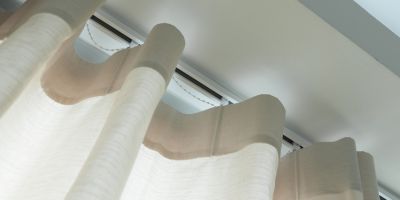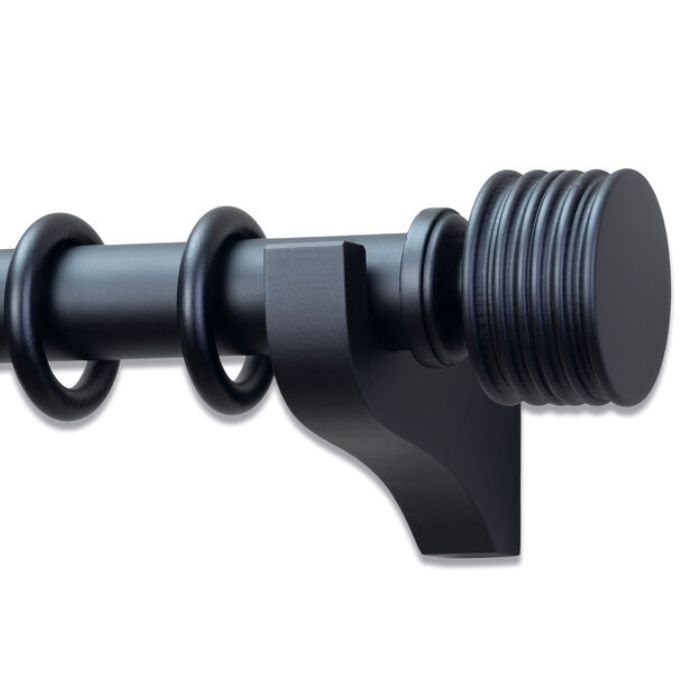Please wait...
A Guide To Choosing Curtain Tracks & Poles
This entry was posted 15/07/2024

When it comes to dressing your windows, one of the first decisions you need to make is whether to opt for a curtain track or a curtain pole. Both have their unique advantages and can drastically affect the look and functionality of your window treatments. To help you make an informed choice, we’ve outlined the key differences and benefits of each option.
Curtain Tracks
What are Curtain Tracks? Curtain tracks are discreet systems, usually made from plastic or metal, that hold and guide your curtains. They are often mounted on the ceiling or wall and have a series of gliders or hooks on which the curtains hang and slide.
Advantages of Curtain Tracks:
- Sleek and Minimalist: Curtain tracks are often hidden from view, creating a clean and streamlined appearance. This is ideal for modern interiors or where you want the focus to be on the curtains themselves.
- Smooth Operation: The gliders on a curtain track ensure smooth and easy operation, making it effortless to open and close your curtains.
- Flexible Design: Tracks can be bent to fit bay windows or other unique shapes, providing a tailored solution for tricky spaces.
- Perfect for Heavy Curtains: Tracks are robust and can support heavier curtains without sagging, making them a good choice for thicker fabrics.

Disadvantages of Curtain Tracks:
- Installation Complexity: Installing curtain tracks can be more involved than poles, often requiring precise measurements and sometimes professional installation.
- Limited Decorative Options: While functional, tracks offer fewer decorative options compared to poles, which can be a drawback if you’re looking to make a statement with your window fittings.
Curtain Poles
What are Curtain Poles? Curtain poles are visible rods, typically made from metal, wood, or plastic, that run across the top of your window. Curtains hang from rings or eyelets that slide along the pole.
Advantages of Curtain Poles:
- Decorative Appeal: Curtain poles come in a variety of styles, finishes, and materials, making them a decorative feature in their own right. From classic wooden poles to modern metal designs, there’s a style to suit every taste.
- Easy Installation: Generally, curtain poles are easier to install than tracks. They come in ready-made kits that can be mounted with simple brackets.
- Versatility: Poles are versatile and can accommodate different types of curtain headings, such as eyelet, tab top, and pencil pleat.
- Adjustable Length: Many curtain poles are telescopic, allowing you to adjust the length to fit your window perfectly.

Disadvantages of Curtain Poles:
- Less Discreet: Curtain poles are always visible, which may not suit all interior styles, especially if you prefer a minimalist look.
- Potential for Noise: Curtains sliding along a pole can sometimes create noise, which might be a consideration for bedrooms or quiet spaces.
- Limitations with Bay Windows: While there are solutions, fitting a curtain pole to a bay window can be more challenging than using a flexible track.
Making Your Decision
Choosing between a curtain track and a pole largely depends on your personal preferences, the style of your room, and practical considerations. Here are a few questions to help guide your decision:
- Aesthetic Preference: Do you want your window treatment to be a feature (pole) or blend seamlessly into the background (track)?
- Type of Curtains: Are your curtains heavy or light? Heavier curtains might benefit from the support of a track.
- Window Shape: Do you have a bay window or another unique shape that might be better suited to a flexible track?
- Installation: Are you comfortable with a more complex installation, or do you prefer a simpler setup?
Both curtain tracks and poles have their own set of advantages and are suitable for different scenarios. By considering the above factors, you can choose the option that best meets your needs and enhances the beauty and functionality of your windows. Happy decorating!
This entry was posted on 15/07/2024

